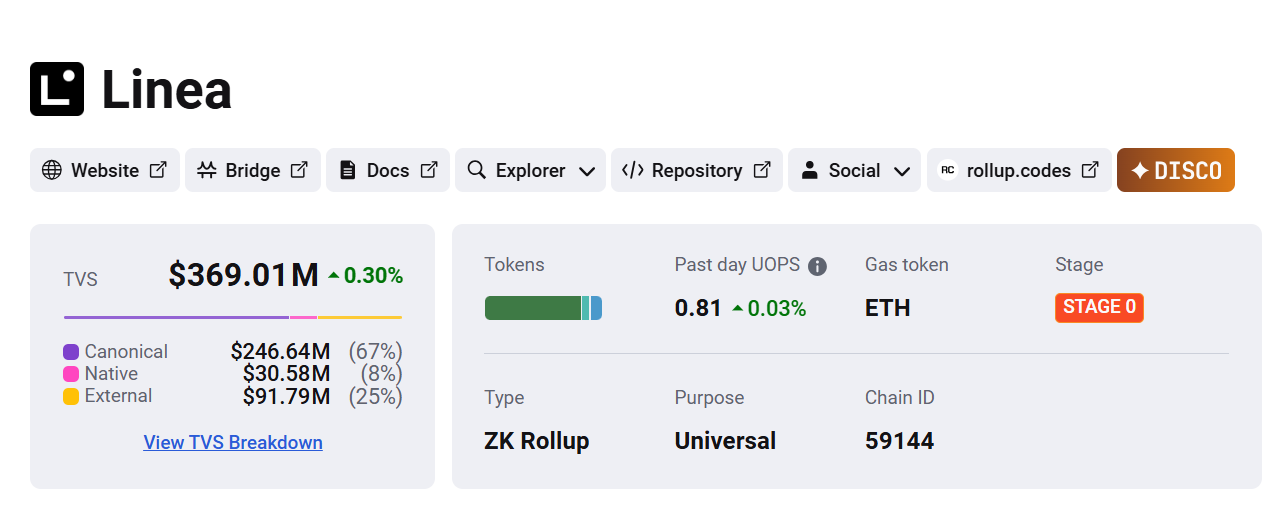| COINOTAG recommends • Exchange signup |
| 💹 Trade with pro tools |
| Fast execution, robust charts, clean risk controls. |
| 👉 Open account → |
| COINOTAG recommends • Exchange signup |
| 🚀 Smooth orders, clear control |
| Advanced order types and market depth in one view. |
| 👉 Create account → |
| COINOTAG recommends • Exchange signup |
| 📈 Clarity in volatile markets |
| Plan entries & exits, manage positions with discipline. |
| 👉 Sign up → |
| COINOTAG recommends • Exchange signup |
| ⚡ Speed, depth, reliability |
| Execute confidently when timing matters. |
| 👉 Open account → |
| COINOTAG recommends • Exchange signup |
| 🧭 A focused workflow for traders |
| Alerts, watchlists, and a repeatable process. |
| 👉 Get started → |
| COINOTAG recommends • Exchange signup |
| ✅ Data‑driven decisions |
| Focus on process—not noise. |
| 👉 Sign up → |
-
Joseph Lubin, founder of Consensys, has confirmed that the Ethereum layer-2 network LINEA will launch a token prior to any MetaMask token release, signaling a strategic shift in Consensys’ tokenization roadmap.
-
Lubin emphasized a phased approach focusing on transforming products into decentralized protocols before issuing tokens, ensuring each token serves a clear purpose within the Web3 ecosystem.
-
In his recent statement on X, Lubin highlighted that LINEA’s token launch is imminent, while MetaMask’s token remains uncertain pending its evolution into a protocol-like structure.
Consensys prioritizes LINEA token launch ahead of MetaMask, focusing on protocolization to ensure meaningful token utility within Ethereum’s expanding layer-2 ecosystem.
Consensys Prioritizes LINEA Token Launch Amid Strategic Protocolization
Joseph Lubin, the visionary behind Consensys, recently clarified the company’s deliberate strategy regarding token launches. Rather than rushing into the market, Consensys is adopting a methodical approach termed “protocolization,” which involves converting existing products into decentralized protocols before issuing tokens. This ensures that tokens are not merely speculative assets but integral components that enhance governance, incentives, and interoperability across Web3 applications.
LINEA, an Ethereum layer-2 scaling solution operated by the Linea Association, is positioned as the first project to receive a token. This move aligns with LINEA’s growing prominence, securing approximately $370 million in total value locked (TVL) and ranking among the top ten Ethereum layer-2 solutions according to L2Beat data.

| COINOTAG recommends • Professional traders group |
| 💎 Join a professional trading community |
| Work with senior traders, research‑backed setups, and risk‑first frameworks. |
| 👉 Join the group → |
| COINOTAG recommends • Professional traders group |
| 📊 Transparent performance, real process |
| Spot strategies with documented months of triple‑digit runs during strong trends; futures plans use defined R:R and sizing. |
| 👉 Get access → |
| COINOTAG recommends • Professional traders group |
| 🧭 Research → Plan → Execute |
| Daily levels, watchlists, and post‑trade reviews to build consistency. |
| 👉 Join now → |
| COINOTAG recommends • Professional traders group |
| 🛡️ Risk comes first |
| Sizing methods, invalidation rules, and R‑multiples baked into every plan. |
| 👉 Start today → |
| COINOTAG recommends • Professional traders group |
| 🧠 Learn the “why” behind each trade |
| Live breakdowns, playbooks, and framework‑first education. |
| 👉 Join the group → |
| COINOTAG recommends • Professional traders group |
| 🚀 Insider • APEX • INNER CIRCLE |
| Choose the depth you need—tools, coaching, and member rooms. |
| 👉 Explore tiers → |
Initially slated for a Q1 2025 token launch, LINEA missed its original timeline but remains on track for a release soon, as per Lubin’s latest update. This token is expected to synergize with other Consensys initiatives, reinforcing a cohesive ecosystem rather than isolated projects.
MetaMask Token Launch Remains on Hold Pending Protocol Evolution
Despite widespread speculation about a MetaMask token, Lubin refrained from confirming any immediate plans. He indicated that MetaMask must first evolve into a more protocol-like entity before a token would be viable. This cautious stance reflects Consensys’ broader commitment to ensuring that tokens have substantive utility and governance roles rather than serving as mere speculative instruments.
| COINOTAG recommends • Exchange signup |
| 📈 Clear interface, precise orders |
| Sharp entries & exits with actionable alerts. |
| 👉 Create free account → |
| COINOTAG recommends • Exchange signup |
| 🧠 Smarter tools. Better decisions. |
| Depth analytics and risk features in one view. |
| 👉 Sign up → |
| COINOTAG recommends • Exchange signup |
| 🎯 Take control of entries & exits |
| Set alerts, define stops, execute consistently. |
| 👉 Open account → |
| COINOTAG recommends • Exchange signup |
| 🛠️ From idea to execution |
| Turn setups into plans with practical order types. |
| 👉 Join now → |
| COINOTAG recommends • Exchange signup |
| 📋 Trade your plan |
| Watchlists and routing that support focus. |
| 👉 Get started → |
| COINOTAG recommends • Exchange signup |
| 📊 Precision without the noise |
| Data‑first workflows for active traders. |
| 👉 Sign up → |
MetaMask, with over 30 million users as of 2024, remains a critical gateway to decentralized applications on Ethereum. However, the team has repeatedly warned users against scams involving fake MetaMask token promotions, underscoring the absence of any official token at this time.
Lubin’s remarks suggest that any future MetaMask token would be part of a carefully coordinated rollout, integrated within a larger Web3 framework that prioritizes decentralization and community governance.
| COINOTAG recommends • Traders club |
| ⚡ Futures with discipline |
| Defined R:R, pre‑set invalidation, execution checklists. |
| 👉 Join the club → |
| COINOTAG recommends • Traders club |
| 🎯 Spot strategies that compound |
| Momentum & accumulation frameworks managed with clear risk. |
| 👉 Get access → |
| COINOTAG recommends • Traders club |
| 🏛️ APEX tier for serious traders |
| Deep dives, analyst Q&A, and accountability sprints. |
| 👉 Explore APEX → |
| COINOTAG recommends • Traders club |
| 📈 Real‑time market structure |
| Key levels, liquidity zones, and actionable context. |
| 👉 Join now → |
| COINOTAG recommends • Traders club |
| 🔔 Smart alerts, not noise |
| Context‑rich notifications tied to plans and risk—never hype. |
| 👉 Get access → |
| COINOTAG recommends • Traders club |
| 🤝 Peer review & coaching |
| Hands‑on feedback that sharpens execution and risk control. |
| 👉 Join the club → |
Implications for Ethereum Layer-2 Ecosystem and Web3 Development
The prioritization of LINEA’s token launch signals a maturation in the Ethereum layer-2 landscape, where projects are increasingly focusing on sustainable growth and protocol governance. By emphasizing “protocolization,” Consensys is setting a precedent for how tokens should be introduced—only after the underlying infrastructure demonstrates robustness and community engagement.
This approach may influence other layer-2 solutions and Web3 projects to adopt similar strategies, fostering a more resilient and interconnected ecosystem. The emphasis on token utility, governance, and interoperability aligns with broader industry trends toward decentralized finance (DeFi) and decentralized autonomous organizations (DAOs).
Conclusion
Consensys’ phased strategy, led by Joseph Lubin, underscores a thoughtful and strategic approach to token launches within the Ethereum ecosystem. With LINEA poised to be the first tokenized protocol, the company is prioritizing meaningful decentralization and functional utility over rapid market entry. Meanwhile, MetaMask’s token remains on hold, contingent on the wallet’s evolution into a protocol-like structure. This measured approach not only mitigates speculative risks but also strengthens the foundation for sustainable Web3 growth.
| COINOTAG recommends • Members‑only research |
| 📌 Curated setups, clearly explained |
| Entry, invalidation, targets, and R:R defined before execution. |
| 👉 Get access → |
| COINOTAG recommends • Members‑only research |
| 🧠 Data‑led decision making |
| Technical + flow + context synthesized into actionable plans. |
| 👉 Join now → |
| COINOTAG recommends • Members‑only research |
| 🧱 Consistency over hype |
| Repeatable rules, realistic expectations, and a calmer mindset. |
| 👉 Get access → |
| COINOTAG recommends • Members‑only research |
| 🕒 Patience is an edge |
| Wait for confirmation and manage risk with checklists. |
| 👉 Join now → |
| COINOTAG recommends • Members‑only research |
| 💼 Professional mentorship |
| Guidance from seasoned traders and structured feedback loops. |
| 👉 Get access → |
| COINOTAG recommends • Members‑only research |
| 🧮 Track • Review • Improve |
| Documented PnL tracking and post‑mortems to accelerate learning. |
| 👉 Join now → |








